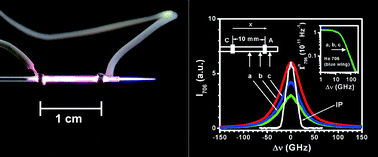Atmospheric helium capillary dielectric barrier discharge for soft ionization: broadening of spectral lines, gas temperature and electron number density
Abstract
The capillary helium dielectric barrier discharge (DBD) operating at atmospheric pressure was investigated by means of optical emission spectroscopy with the aim to determine the dominant broadening mechanism of the helium spectral lines, gas temperature and electron number density. The dependence of emission profiles of helium 388 nm, 501 nm, 587 nm, 667 nm, 706 nm and 728 nm lines on discharge voltage, helium pressure and position along the DBD capillary was investigated. Also, the pressure and voltage dependence of the profiles of hydrogen H-alpha and H-beta lines was examined. The Lorentzian widths of the normalized helium line profiles were found to be constant with respect to the applied voltage and the position along the capillary. The dominant broadening mechanism for all investigated lines was identified to be due to collisions with ground-state helium atoms, with the Stark broadening being negligible. It was determined that the temperature of the gas was constant along the capillary and independent of the voltage applied on the DBD electrodes and that its value coincided with the room temperature. The measurements of the dependence of the Lorentzian width of hydrogen H-alpha and H-beta lines on helium pressure, combined with gas temperature determined in the experiment, yielded the following values for the broadening parameters due to broadening by neutral helium: γνHe(Hα) = 1.56 × 10−9 cm3 s−1 and γνHe(Hβ) = 3.16 × 10−9 cm3 s−1. From the analysis of the measured H-alpha and H-beta line profiles the upper limit of the electron number density in the investigated plasma was obtained as ne ≤ 1.4× 1012 cm−3.


 Please wait while we load your content...
Please wait while we load your content...